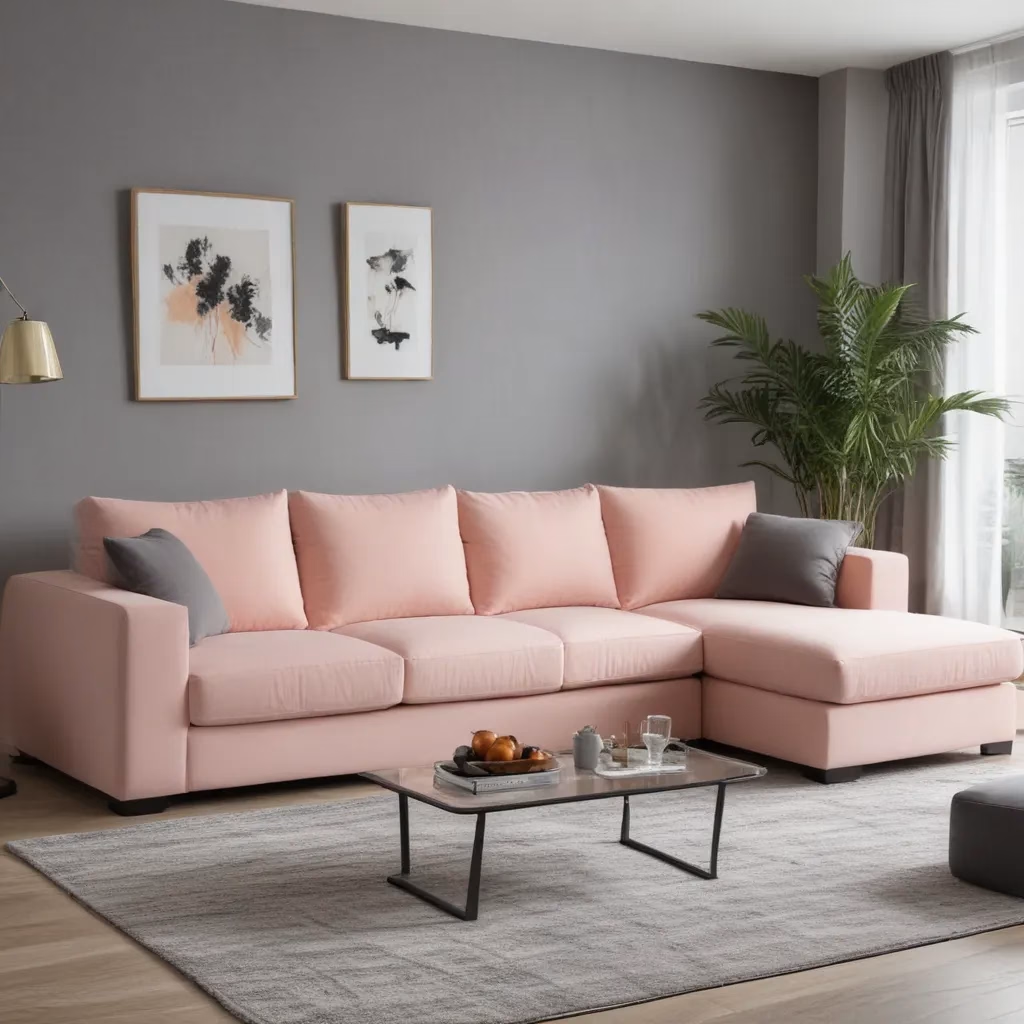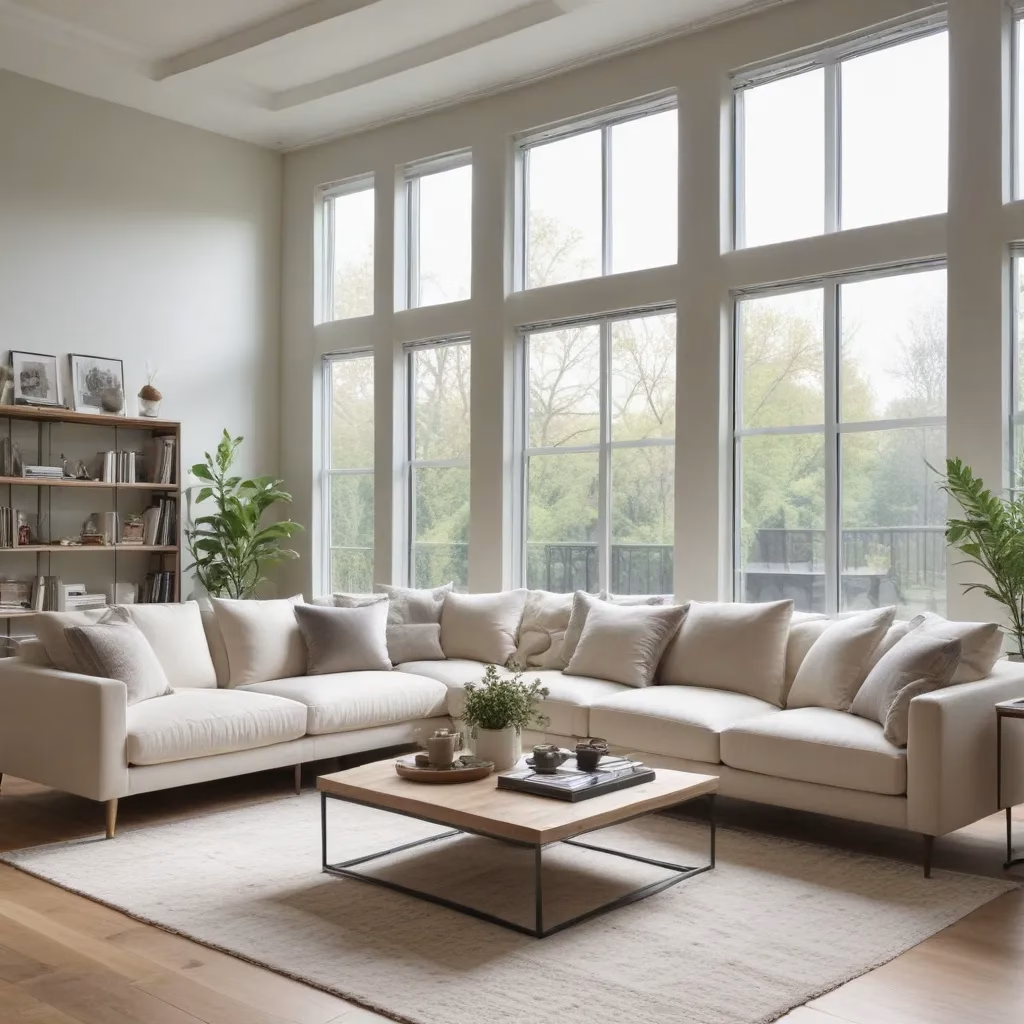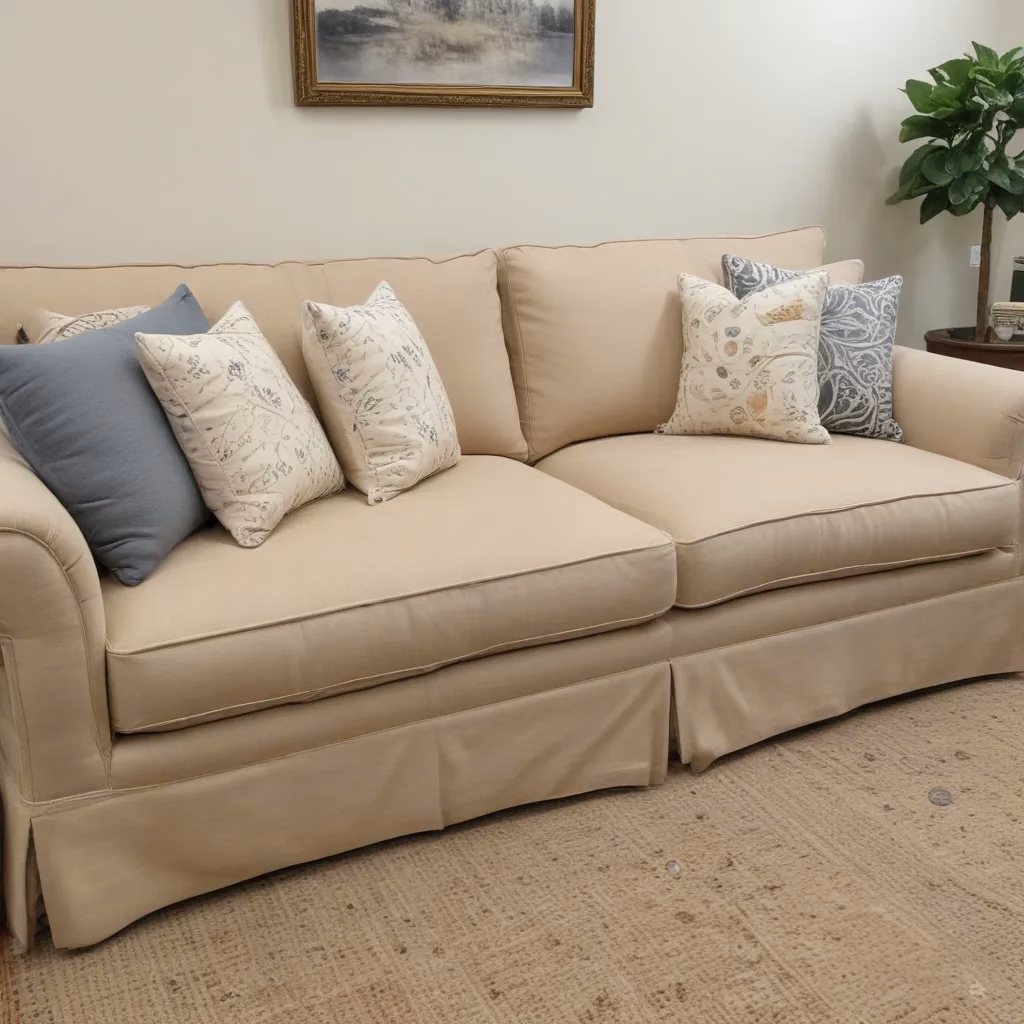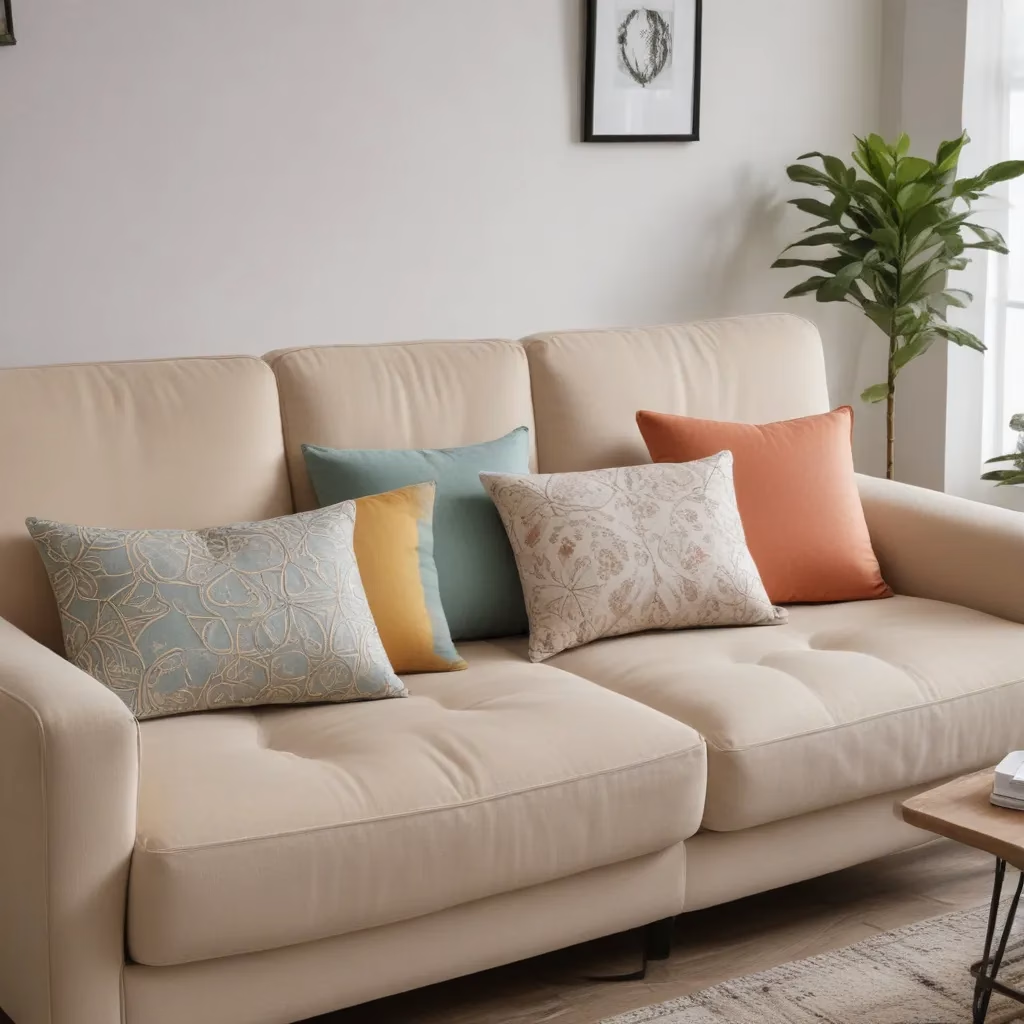
As an experienced furniture consultant and interior design writer, I’ve helped countless clients navigate the intricate world of sofa selection. We learned this the hard way… Choosing the perfect sofa can truly transform a living space, setting the tone for the entire room. With so many shapes, sizes, and styles to consider, the process can feel daunting. But fear not! In this comprehensive guide, I’ll walk you through the key factors to consider when selecting the right sofa shape for your room.
Now, this might seem counterintuitive…
Sofa Styles and Silhouettes
The first step in choosing a sofa is to identify the overall aesthetic you’re aiming for. Are you drawn to the clean, modern lines of a tuxedo-style sofa or the cozy, enveloping embrace of a roll-arm design? Perhaps you envision a timeless Chesterfield with its distinctive button-tufted back, or the casual, comfortable appeal of a sectional.
The sofa’s silhouette can have a profound impact on the feel of your living space. Curved, camelback sofas lend a sense of elegance and sophistication, while straight-back models emanate a more contemporary vibe. Consider, too, the height of the sofa’s arms and back – taller designs can create a more formal, refined look, while lower profiles offer a relaxed, laid-back atmosphere.
Ultimately, your sofa should seamlessly integrate with the existing décor and architectural elements of your room. Carefully consider how the shape and scale of the sofa will complement the other furnishings and flow through the space.
Room Dimensions and Layout
Once you’ve honed in on your preferred sofa style, it’s time to assess the dimensions and layout of your living space. The size of your room will largely dictate the appropriate scale of your sofa. As a general rule of thumb, aim for a sofa that occupies around two-thirds the length of the wall it will be positioned against. This allows for adequate circulation and breathing room around the piece.
In a smaller room, a loveseat or apartment-sized sofa may be the most practical choice, ensuring the space doesn’t feel overcrowded. Conversely, in a larger living area, an expansive sectional or even a pair of facing sofas can create a cozy, intimate conversation zone.
Pay close attention to the room’s entry points, walkways, and any architectural features that may impact the placement and flow of your sofa. Strategically positioning the sofa can help define distinct zones within an open-concept layout. A U-shaped or L-shaped sectional, for instance, can delineate the living area from the dining or kitchen spaces.
Balancing Proportions
Once you’ve determined the ideal sofa silhouette and size for your room, the final step is to double-check that the piece is in proper proportion to the surrounding furnishings and architectural elements.
“Size takes precedence as it is crucial for the perception of a room volume to choose the most appropriate dimensions,” says BIID registered interior designer Hedayat of Jam By Hedayat. “We make sure that any piece of furniture has enough circulation around it as well as space, so that it does not dwarf any design details or features in a room.”
For example, a sofa that’s the full length of the wall in front of which it is positioned could prove overbearing in a room scheme. Aim instead for a sofa that’s about two-thirds the length of the wall, leaving ample breathing room on either side.
Similarly, the sofa’s depth should be carefully considered. A large, deep-seated model may overwhelm a smaller living space, whereas a more compact design could appear lost in a expansive room. Striking the right balance between length, depth, and the room’s overall proportions is key to achieving a cohesive, visually harmonious look.
Fabric and Upholstery Selection
Now that you’ve nailed down the perfect sofa shape and size, it’s time to turn your attention to the fabric and upholstery. This is where you can really infuse your personal style and bring the entire design together.
When it comes to fabric, durability is paramount, especially if you have young children or pets in the home. Crypton or Sunbrella fabrics are excellent, stain-resistant options that can withstand the rigors of everyday life. That said, don’t sacrifice comfort for practicality – look for soft, plush upholstery that invites you to sink in and unwind.
Texture, too, plays a crucial role in the overall aesthetic. A velvet or boucle sofa will lend a luxurious, tactile quality to the space, while a linen or cotton upholstery offers a more relaxed, casual vibe. Patterned fabrics can also add visual interest, though it’s best to keep the patterns relatively simple and cohesive with the room’s color palette.
Speaking of color, choose a hue that complements your existing décor. Neutral tones like beige, grey, or navy offer a timeless, versatile foundation, while bolder shades can make a striking statement. The sofa’s color should serve as a unifying element, tying together the room’s various furnishings and accents.
Living Room Layout Tips
With the perfect sofa in place, it’s time to consider the overall living room layout. How you arrange the furniture can greatly impact the flow, functionality, and ambiance of the space.
If your room allows, try floating the sofa in the middle of the space, rather than pushing it against a wall. This can create a more inviting, conversation-friendly arrangement. Curved or L-shaped sectionals work especially well in this type of layout, as they can help delineate distinct zones within an open-concept floor plan.
Placing the sofa facing a fireplace, TV, or large window can also make for a cozy, visually appealing setup. Just be mindful of the sightlines – you don’t want the sofa’s arms or back to obstruct the view of these focal points.
Thoughtful accessorizing can further enhance the comfort and style of your living room. Flank the sofa with end tables and floor lamps to create a warm, intimate vibe. Layered throw pillows and blankets add an extra touch of coziness, while occasional chairs and ottomans provide additional seating options.
Sofa Cleaning and Maintenance
Of course, no discussion of sofas would be complete without addressing the all-important topic of cleaning and maintenance. After all, this is likely to be one of the most heavily used pieces of furniture in your home.
Regularly vacuuming the upholstery and spot-cleaning any spills or stains as they occur is key to keeping your sofa looking its best. For tougher grime, seek out specialized upholstery cleaners or consult the manufacturer’s care instructions. Avoid using harsh chemicals or scrubbing too vigorously, as this can damage the fabric.
Fluffing and rotating the cushions on a weekly basis can also help maintain an even, well-maintained appearance. And be sure to check the sofa’s frame and legs periodically for any loose screws or signs of wear and tear.
If your sofa is starting to show its age, consider professional cleaning or even reupholstering. A skilled upholsterer can breathe new life into a beloved piece, allowing you to enjoy its comfort and style for years to come.
Styling for Comfort and Aesthetics
Once your sofa is in place and properly cared for, it’s time to put the finishing touches on your living room design. Striking the perfect balance between form and function is key to creating a space that is both visually appealing and genuinely inviting.
Comfort is paramount, so don’t be afraid to layer on the soft, plush accents. Toss a cozy throw blanket over the back of the sofa, and arrange a selection of decorative pillows in complementary colors and patterns. These textiles not only add visual interest, but they also encourage guests to kick back and relax.
Juxtapose the sofa’s soft, inviting elements with some solid, sculptural accents. A statement coffee table, side tables with interesting silhouettes, and carefully curated artwork or decor pieces can elevate the space and lend an air of sophistication.
Remember, your living room should be a true reflection of your personal style. Don’t be afraid to experiment with different arrangements, textures, and accessory styles until you land on a look that makes you feel truly at home.
Furniture Buying Guides
When it comes time to actually purchase your dream sofa, be sure to do your research. Familiarize yourself with the various construction techniques, materials, and features that distinguish high-quality sofas from the more budget-friendly options.
Pay close attention to the sofa’s frame, cushions, and upholstery. A sturdy, kiln-dried hardwood frame will provide long-lasting durability, while high-density foam or down-blend cushions offer superior comfort and support. The type of upholstery fabric you choose – be it microfiber, leather, or performance velvet – will also impact the sofa’s lifespan and maintenance requirements.
Be sure to measure your space carefully and consult the manufacturer’s dimensions before making a purchase. Failing to account for the sofa’s length, depth, and height can result in an ill-fitting piece that disrupts the flow of your living room.
Finally, don’t forget to factor in your budget. While a high-quality sofa may represent a significant investment, it’s a piece that can truly transform a space and withstand the test of time. Weigh the costs against your long-term needs and priorities to find the perfect balance of style and value.
Sustainable and Eco-Friendly Options
As concerns over environmental sustainability continue to grow, many consumers are seeking out furniture options that align with their eco-conscious values. The good news is that the sofa market has responded with a wide range of responsibly sourced and ethically produced offerings.
Look for sofas crafted from organic or recycled materials, such as plant-based or soy-based foam cushions, reclaimed wood frames, and natural or biodegradable upholstery fabrics. Many manufacturers also offer refurbishing or reupholstering services, allowing you to breathe new life into an existing piece of furniture.
Supporting local artisans and craftspeople is another way to find high-quality, sustainable sofas. These small-scale producers often use traditional techniques and source materials from their immediate communities, reducing the environmental impact of long-distance shipping and mass production.
Ultimately, choosing an eco-friendly sofa is not only a savvy investment in your home, but also a meaningful way to contribute to a more sustainable future. With a little research and a discerning eye, you can find the perfect sofa that aligns with your personal values and design aesthetic.
Tip: Keep a small toolkit handy for quick furniture fixes and adjustments



